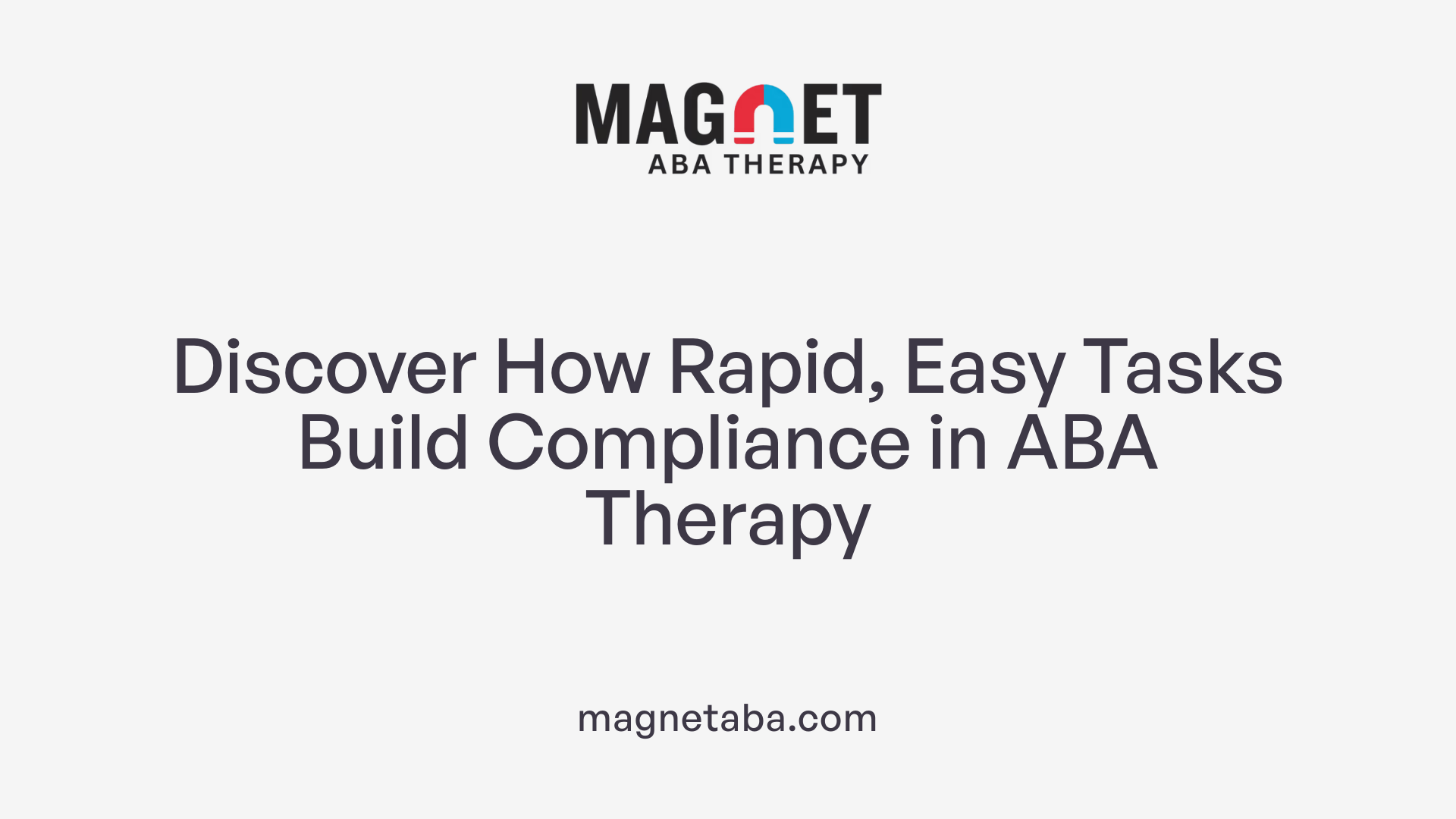Introduction to Behavioral Momentum in ABA Therapy
Behavioral momentum is a powerful strategy utilized in Applied Behavior Analysis (ABA) therapy, especially for children with autism spectrum disorder (ASD). By using a sequence of easy, high-probability tasks followed by more challenging demands, therapists can increase compliance, ease transitions, and effectively reduce challenging behaviors. This article explores what behavioral momentum is, how it works, and practical ways to implement it in therapeutic settings to improve engagement and outcomes.
Understanding Behavioral Momentum and Its Psychological Foundations

What is behavioral momentum?
Behavioral momentum is a strategy used in Applied Behavior Analysis (ABA) therapy designed to increase compliance by beginning with a series of easy, high-probability (high-p) behaviors. These are actions that the child enjoys and can perform readily. By successfully completing these simple tasks, the child builds positive momentum, making it more likely they will comply when presented with a more challenging, low-probability (low-p) behavior later on.
What are high-probability and low-probability behaviors?
High-probability behaviors are tasks that a child is likely to complete successfully and willingly—typically compliance rates are 80% or higher. Examples include clapping, jumping, or spinning. Low-probability behaviors are more difficult or less preferred tasks that the child complies with less than 50% of the time, such as putting on shoes or sitting at the table. Behavioral momentum uses a sequence of high-p requests to create a positive flow that supports compliance with low-p tasks.
What behavioral psychology principles underpin behavioral momentum?
The technique draws from the principle that behavior patterns showing high rates of compliance are more likely to continue when momentum is maintained. By eliciting a quick succession of easy, reinforcing tasks, the approach capitalizes on the natural tendency to continue behavior that has been consistently rewarded. Positive reinforcement, such as praise or access to preferred activities, plays a crucial role in sustaining engagement and compliance.
What scientific studies validate behavioral momentum?
Decades of research support the effectiveness of behavioral momentum. Seminal studies by Mace et al. (1988) and Davis et al. (1992) demonstrated that delivering high-p requests prior to low-p requests significantly increased compliance in children with behavior disorders, including those with autism. These studies confirm that building momentum with easy tasks reduces escape-motivated behaviors and facilitates smoother transitions and learning in therapy.
The behavioral momentum approach, grounded in a solid scientific foundation, offers a practical and evidence-based method to enhance cooperation and success in children receiving ABA therapy.
The Mechanics of Behavioral Momentum: How It Works in Practice

How is behavioral momentum implemented?
Behavioral momentum begins by identifying high-probability (high-p) behaviors that the child is likely to comply with at least 80% of the time, alongside low-probability (low-p) behaviors which are more challenging or less preferred. The technique involves asking the child to perform 3 to 5 easy, enjoyable tasks in rapid succession. These high-probability requests might include actions like clapping, jumping, or spinning — behaviors that the child readily performs.
Rapid succession of easy requests and timing
These easy requests are delivered quickly, often within seconds of each other, creating a rhythm that builds momentum. Immediately after the last high-p request and its reinforcement, the therapist presents the low-probability task. The timing is crucial: presenting the challenging request within about five seconds while the child remains attentive increases the likelihood of compliance.
Use of positive reinforcement
After each high-p request, positive reinforcement is given promptly to encourage the behavior. This reinforcement might be verbal praise, access to preferred toys, or other rewards meaningful to the child. Reinforcement maintains engagement and sets a positive context for following the more difficult request.
Importance of proximity and clarity
Demands are stated clearly and delivered near the child to maintain their focus. The proximity ensures the child understands what is being asked and can more easily respond to the sequence of requests.
By combining rapid, easy requests with immediate praise and well-timed, clear demands, behavioral momentum capitalizes on the child's readiness to comply, making it easier to achieve cooperation with harder tasks. This structured approach leads to smoother transitions, improved compliance, and more effective learning in therapy sessions.
Practical Examples and Applications of Behavioral Momentum

Examples of high-p and low-p tasks
Behavioral momentum uses a sequence of high-probability (high-p) tasks—simple actions that a child enjoys and can easily complete—to build momentum. Examples of high-p tasks include clapping hands, jumping, or spinning. After these easy requests, a therapist or caregiver moves to low-probability (low-p) tasks, which are more challenging, such as putting on shoes or sitting at the table.
Using behavioral momentum to ease transitions
This technique is especially effective for easing transitions. For instance, moving a child from playtime to mealtime can be difficult, but starting with quick, enjoyable requests creates a flow that makes the transition smoother. Quickly offering several high-p requests with positive reinforcement helps the child adjust and comply with the more demanding transition task.
Application in multi-step instructions and daily activities
Behavioral momentum aids in teaching multi-step instructions by first engaging the child in easy, familiar steps. This approach builds confidence and cooperation, enabling smoother progression through daily routines like getting dressed or completing classroom assignments. The rapid sequence of easy tasks followed by more complex demands promotes engagement and reduces resistance.
Addressing escape-maintained behaviors
Children sometimes engage in behaviors to avoid or escape tasks they find difficult or unpleasant. Behavioral momentum helps address these escape-maintained behaviors by reinforcing a chain of successful task completions before introducing more challenging requests. This strategy lessens the likelihood that the child will attempt to avoid the task, improving compliance and reducing problematic behaviors.
Together, these examples demonstrate how behavioral momentum supports greater cooperation and eases the challenges of teaching and daily transitions in autism therapy.
Benefits of Behavioral Momentum in Autism Therapy

Increasing compliance and engagement
Behavioral momentum helps increase compliance by starting with simple, enjoyable tasks that the child is likely to complete. This creates a positive momentum that makes following more challenging directions easier. As a result, therapy sessions become more productive and engaging for children with autism.
Reducing challenging behaviors
By building a flow of successful task completions, behavioral momentum reduces the likelihood of escape or avoidance behaviors. When children experience frequent positive reinforcement from easy tasks, they are less likely to resist or act out during difficult requests.
Improving confidence and cooperation
Starting with achievable tasks allows children to experience success early on, which boosts their confidence. This positive experience encourages cooperation and active participation in therapy, fostering a stronger therapeutic relationship.
Facilitating generalization across settings
Behavioral momentum is most effective when applied consistently across multiple environments. Training caregivers and other adults to use the strategy helps children generalize learned behaviors beyond therapy sessions, supporting skill maintenance and application in daily life.
Overall, behavioral momentum provides a structured approach that smoothes transitions, improves motivation, and enhances learning outcomes for individuals with autism by gradually increasing task difficulty while maintaining positive reinforcement.
Integrating Behavioral Momentum with Other ABA Techniques
How does behavioral momentum fit with other ABA strategies?
Behavioral momentum is frequently integrated with other Applied Behavior Analysis (ABA) techniques like reinforcement, prompting, and shaping to enhance the overall effectiveness of interventions. This combination leverages the strengths of each approach to create a more comprehensive system for behavior change.
Combination with reinforcement, prompting, and shaping
- Reinforcement: Positive reinforcement such as praise or access to preferred activities maintains the momentum generated by high-probability request sequences, encouraging ongoing compliance and engagement.
- Prompting: Therapists often introduce prompts to assist with task completion during early stages and gradually fade them as the child becomes more independent, facilitated by the momentum created.
- Shaping: Behavioral momentum sets the stage for shaping, which involves gradually teaching more complex or challenging behaviors by reinforcing successive approximations. This ensures that children are not overwhelmed and can build skills step-by-step.
Role within broader behavior analysis
Behavioral momentum acts as a catalyst within ABA by increasing the likelihood that children will comply with challenging requests after experiencing a string of easy, successful tasks. Its integration with ABA promotes smoother transitions, reduces escape behaviors, and supports skill generalization across settings.
Enhancing effectiveness through multi-strategy approaches
By combining behavioral momentum with other strategies, therapists provide a structured and holistic framework. This multi-strategy approach improves confidence, cooperation, and learning outcomes in children with autism, facilitating more consistent progress across therapy sessions and everyday situations.
Challenges and Considerations in Using Behavioral Momentum
What challenges exist when applying behavioral momentum?
One of the main challenges in using behavioral momentum is maintaining consistency across all individuals involved in the child's care. For the technique to be effective, therapists, caregivers, and educators need to implement the strategy uniformly. Inconsistencies in how demands, reinforcement, and sequencing are delivered can disrupt the momentum and reduce compliance.
Selecting appropriate reinforcers is another critical factor. Reinforcers must be motivating and meaningful to the child to maintain interest and encourage repetition of desired behaviors. If the chosen incentives fail to engage the child, the effectiveness of behavioral momentum diminishes, making it harder to elicit compliance with more challenging tasks.
Collaborative planning with caregivers and other team members plays a vital role in ensuring that behavioral momentum strategies are applied consistently and successfully. Training and clear communication between all parties help promote the generalization of learned behaviors to different settings and routines, increasing the likelihood of long-term success.
Ongoing monitoring and data collection are essential components for refining the approach. By tracking progress, therapists can adjust the selection of high-probability requests, reinforcers, and delivery methods to maximize the technique's impact. This systematic evaluation also helps identify when fading prompts or reinforcements are appropriate to maintain behavior improvements over time.
These considerations highlight that while behavioral momentum is a powerful tool in ABA therapy, its effectiveness depends heavily on careful planning, consistency, and teamwork among those supporting the child.
Maximizing the Impact of Behavioral Momentum: Tips for Practitioners and Caregivers

How can therapists and caregivers maximize the effectiveness of behavioral momentum?
To maximize behavioral momentum, accurately identifying high-p and low-p behaviors is essential. High-p behaviors are easy tasks that the child enjoys and readily performs, while low-p behaviors are more challenging tasks that the child is less likely to complete. This clear distinction enables practitioners to design effective sequences starting with tasks that build confidence.
Delivering requests rapidly and clearly helps maintain the momentum built from successful task completion. Requests should be stated simply and given in quick succession to keep the child engaged and prevent distractions. Typically, presenting 3-5 high-p requests in sequence, followed immediately by a low-p request, within about 5 seconds after reinforcing the easy tasks, ensures a smooth transition.
Using meaningful reinforcement is vital; praise, favorite activities, or preferred items serve as positive feedback that encourages repetition of the desired behavior. This reinforcement maintains enthusiasm and strengthens the behavior chain.
Encouraging generalization expands behavioral momentum's effectiveness beyond therapy sessions. By involving various caregivers and therapists in implementing the same procedure, children learn to respond consistently across different settings and with different people, enhancing the real-world utility of learned behaviors.
Fading prompts and gradually reducing the number of high-p requests are crucial for promoting independence. This prevents reliance on constant prompting and ensures the child can perform low-p tasks without needing a lengthy series of easy requests, supporting maintenance and generalization over time.
Conclusion: Harnessing Behavioral Momentum for Positive Therapeutic Outcomes
Behavioral momentum stands out as a scientifically supported and practical strategy to enhance compliance and reduce challenging behaviors in children with autism. By carefully sequencing high-probability requests and reinforcing successes, therapists can build a positive flow that leads to engagement with more difficult tasks. When combined thoughtfully with other ABA techniques and supported by consistent implementation and collaboration among caregivers, behavioral momentum can significantly improve the effectiveness of autism therapy and the quality of life for those involved.












